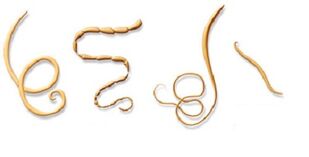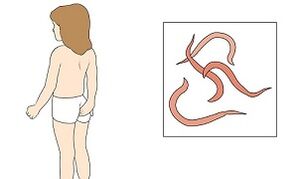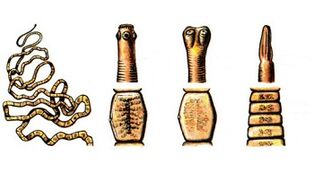Various types of parasites can stay in the human body for a very long time, causing very specific health hazards.
A large number of people suffer from serious diseases caused by parasites. At the same time, many are unaware of the presence of pests in the intestines and other organs.
Every species of parasite known to science has its own characteristics that adults should know.
Risk of Infection

At present, science knows more than 200 species of parasites, of which the human body is a habitat.
Ways and means of penetrating pests into the best habitat have been studied in detail. We can say that each type of parasite has its own "specialization".
A large number of helminths live in the gastrointestinal tract. There are also parasites of the liver, lungs and even the brain.
Almost everyone suffers from parasitic attacks. Just like adults or breastfed babies.
The biggest danger is the presence of parasites in children. First of all, this can be seen in the state of health. Babies often get sick for no apparent reason.
There are delays in physical and mental development. It is not so easy to identify the cause of malaise, although it is often "located" in a clear view.
Enough to conduct specific studies, identify the type of parasite and prescribe treatment.
A large number of adults are at risk, as their professional activities involve the processing of raw materials contaminated with worms.
Some parasitic species are very resistant to environmental influences and can be destroyed with difficulty.
Pest Varieties
The appearance of parasites in the human body is always accompanied by certain signs.
The peculiarity of this condition is that the symptoms are often very weak and it is difficult to detect the presence of pests without special studies.

The following types of helminths are parasites on the body:
- round; pita
- ;
- changed.
This classification is organized taking into account external characteristics, while, regardless of its species, parasites have many common characteristics.
Suction hooks and cups of various shapes are designed to make it easier for parasites to improve their position in certain places.
The life cycle of many parasites consists of several stages. Moreover, tapeworm-like species have two "owners" - a male and a pet.
Closed loop migration provides these pests with the ability to exist and reproduce. In the process of moving, parasites enter the human body and eat it.
This feature exists in all microorganisms that live in the gut or other organs. Only useful species are included in creative activities, and parasites are included in destructive activities.
Given this situation, humans need to support the beneficial and suppress pests.
Round Worms
Round worms include ring worms. It is an orange parasite and has no suction.
The shape of the spindle allows it to move through various organs and penetrate the smallest openings and folds. This type of parasite is able to attack the lungs or pancreas.
Eggs born of ringworm are protected by strong shells that can withstand the damaging effects of hydrochloric acid in the stomach. Often, people become infected by eating unwashed vegetables and fruits.
Pinworm enters the human body in the same way. In appearance, it is a thin striped worm of pale gray, growing up to 10 mm in length. Already at the larval stage, parasites begin to harm humans.

Growing into adult specimens, the larvae secrete toxic enzymes that irritate the intestinal mucosa.
Adult cream worms are able to penetrate into the lining of the small intestine and penetrate it. Under such conditions, a serious disease called peritonitis develops.
Another round parasite that infects large intestinal parasites is the whip worm.
When swallowed, the following symptoms appear:
- headache and dizziness;
- persistent abdominal pain;
- sleep disorders.
Vlasoglav got its name from its external features - this worm is very thin and reaches a length of 50 mm. Parasites are the causative agent of trichocephalosis.
The body never leaves its limits - worms can only be destroyed, after which parasites come out along with feces.
Tapeworm
The appearance of parasites in humans follows a similar scenario. Pig and cow tapeworms in the form of tapeworms enter the body as they each eat meat, pork and beef contaminated by the Finns.
In appearance, this Finnish, or larva, is a white bubble and resembles a millet groet.
Upon reaching the intestines, the larvae become strong and begin to develop into full parasites. Its development is not symptomatic in most cases.
After about three months, tapeworms can reproduce. This type of pest reaches a length of ten meters or more.
The presence of tapeworms in the body causes serious meningitis. A more serious threat to human health is the Echinococcus parasite.

For this parasite, the human body is the middle paradise. The main owners are animals - dogs and cats. People become infected when they come in contact with their pets through the digestive tract - through the mouth.
After reaching the intestine, the egg begins to develop into a larva, which has six hooks for fixation.
With blood flow, they are carried to various organs and most often glued to the liver and lungs.
Growing up, echinococcus begins to destroy the surrounding tissue. Sometimes large enough parasites are mistaken for tumors.
Alveococcus is another representative of the tape parasites in the human body. Upon penetration into the intestine, the larvae develop intensively and penetrate into the small intestinal wall and are carried by the bloodstream to various organs and systems.
Like echinococcus, the parasite stays in the liver and begins its destructive activity.
Alveococcus takes the form of a tiered bladder called larvocyst. These larvocysts are able to invade liver tissue and become cancer-like metastases.
Blood supply to liver tissue is disrupted, necrosis begins, which poses a serious danger to human health and even life.
Fluke Worms
The tapeworm list contains a separate species of parasite called flukes.
The following species are dangerous flux:
- cat coincidence;
- fasciola;
- schistosoma.

Liver pathology is more common in human diseases than in other organ diseases. The flukes got their name because of their anatomical structure.
On the parasitic body there are several sucking cups, with the help of which the mite is trapped in certain places and penetrates deep into the living tissue.
Fluke fluke is most commonly found in the bile ducts and pancreatic ducts.
Fluke enters the human body along with fish that is not yet salty enough or boiled.
In people infected with this mite, the temperature rises sharply, an absurd cough appears, and a rash appears on the body. If you do not take emergency measures, then the person may die.
Fasciola is absorbed into the body by drinking water without boiling. With patient involvement, it causes chronic jaundice.
Schistosomiasis, which is caused by a rare parasite, has become more common in recent years.
This fact is explained by the fact that a large number of people began to visit tropical countries where these pests are widespread.
Precautions
Medical practice shows that parasites take root in the gut more often than other organs.
Mites of various species can adapt to life in the liver, lungs, heart, brain and even the eyes - only this list provides an adequate picture of the dangers of parasites posed to human health and full life.

Different types of parasites can enter the body individually and in combination, which increases the severity of the lesion.
To prevent pests into your body, it is enough to follow the basic rules of hygiene and food hygiene requirements.
Young children should be under constant supervision, especially in the summer when traveling to the country or to the sea.
Today there is no need to eat raw meat or fish, including sliced meat. This atavism should be abandoned forever in the past, so as not to expose your body to unnecessary risks.
















































